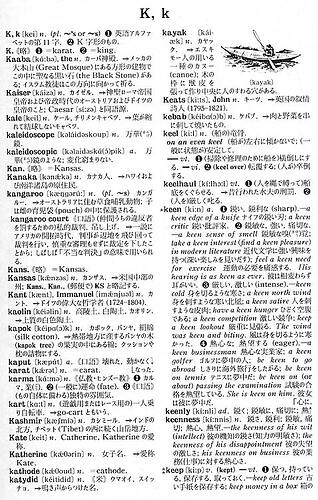I bought two small dictionaries recently. The one is THE NEW CROWN JAPANESE-ENGLISH DICTIONARY edited by Yamada Kazuo, and the other is THE NEW CROWN ENGLISH-JAPANESE DICTIONARY edited by Kawamura Jujiro. The latter is the fifth edition of the dictionary, which was first published in 1954. Believe it or not, It does not show the difference between countable nouns and uncountable nouns, which can be seen in almost any new dictionary edited for learners of English published in Japan. Besides, compared with the other dictionaries of the same size, its grammar notes are minimal. You might wonder why I bought this dictionary. It is because of the useful example sentences that the dictionary has been enjoying general popularity.
Thank you for the trip down memory lane! You won’t believe this (neither can I) - but * I have* the English-Japanese 4th edition!
I was awarded this in 1979 for winning second prize in my State’s annual high school Japanese speech contest (final year).
I didn’t mind coming second. The first prize winner had Japanese parents ( ͡° ͜ʖ ͡°)
When I entered high-school in 1964, I bought the English-Japanese dictionary. I don’t know whether that was the first edition or the second edition. I also feel nostalgic to notice that the latest edition’s cover is still vermilion as it used to be. That revives old memories for me.
It looks cool. It also has historic value because I can see it has a certain amount of out-of-date language, like the entry for ‘keen,’ for example. Hardly anyone goes around saying ‘keen’ anymore, except for maybe “a keen sense of” humor, hearing, smell, etc. You would rarely, if ever, hear anyone saying, “I’m keen on tennis” or “She is keen on him” anymore.
When I was in college, a friend of mine from Japan left behind a handy little Japanese Pocket Interpreter 6-language Conversation Book for Travelers. It’s 350 pages long and has Japanese, English, French, Italian, Portuguese and Spanish laid out in 6 columns across 2 pages. It has a lot of familiar phrasebook categories: basic conversation, on the plane, arrival at the airport, departure, at the hotel, at the restaurant, getting around, public transportation, sightseeing, shopping, mail, telephone, theft, illness, pharmacy and basic words. It must be out of print now because I can’t even find it by ISBN search: 4533013236
Ooh, ooh, I just changed my desktop color to vermilion, RGB: 217, 96, 59. I like it.
"You would rarely, if ever, hear anyone saying, “I’m keen on tennis” or “She is keen on him” anymore. "
The first edition of the English-Japanese dictionary edited by Kawamura Jujiro was published in 1954.
I wonder whether the expression “be keen on” used to be employed only by young people. In the 1950s, a young man might have said, “I am keen on her,” or “I am keen on tennis,” but he might have little chance to use the same phrase today after at least sixty years have passed.
Yes, I think you are right. Such expressions were mostly used by young people of that generation, especially “I am keen on him” or “I am keen on her.” The expression “I am keen on” is still in use today, but not to the extent that it was in the 50’s. Much like asking someone, “Will you go steady with me?” or announcing, “We are going steady,” it is old-fashioned.
(Remember this is from an American perspective. I would be curious to hear what other members think.)
Common usage: a keen critic, a keen sense of smell, take a keen interest
Old fashioned, or infrequent, but nevertheless in usage: a keen hunger, be keen on passing the exam, keen edge of the knife, he was keenly disappointed
More infrequent: keenness of one’s intellect, the keenness of one’s wit, keen-edged, a keen competition
We used “going steady” commonly as twenty-somethings in the 80s!
Apparently old Canadian dudes still use it. “Keen language learner” for example.
I commenced high school in 1975 ( ͡° ͜ʖ ͡°)
Lots of language keeners here, I see.
Do you think that the concept of “品格(grace,dignity)” is pertinent to editing a dictionary for learners of a foreign language? In the preface of the sixth edition of THE NEW CROWN JAPANESE-ENGLISH DICTIONARY, the two editors who undertook the task of revising the old one edited by the late Yamada Kazuo, used the word. I imagine that they were referring to the “subdued” style of editing, namely, no photographs, minimal use of color, use of fonts at the same point size, etc. What do you think of this?
